On reflection...
 Roy
Wilce was judge of the Crufts Team qualifier and the Mini Agility class at Severnside on 29
August 1992. While waiting for Chris to finish judging in another ring, there was plenty of
time to reflect on the day's events. Here are a few of his thoughts shared for the benefit of
competitors, potential judges and show managers alike. Roy
Wilce was judge of the Crufts Team qualifier and the Mini Agility class at Severnside on 29
August 1992. While waiting for Chris to finish judging in another ring, there was plenty of
time to reflect on the day's events. Here are a few of his thoughts shared for the benefit of
competitors, potential judges and show managers alike.
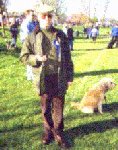 Thoughts
on... whistle starts Thoughts
on... whistle starts
Not my usual style to start after the judge's whistle, it
feels formal and officious, but it did seem appropriate for electronic timing. However, I did
find it was much more positive and quicker than a load of head nodding. It certainly helped to
focus the attention of handlers and ring party alike. Unfortunately, some handlers discovered
that their dogs start on the whistle and not on the handler's command and were left wondering
where the dog had gone!
Thoughts on... electronic
timing
I have mixed feelings on this one. It is difficult to place the beam stands so they
are close enough to the finish that the dog cannot miss it, but far enough away that long
jumping dogs do not jump the beam completely, also wide enough for the dog to comfortably run
through, but narrow enough for the handler to miss them. In the team class at least a dozen
dogs went through the beam without stopping the time display.
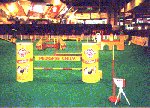 I found my back-up timer Helen Dorman was
essential. Apart from timing, she was also able to chivy handlers and tote their leads like no
electronic timer I know. Several handlers were disadvantaged when the dogs passed the outside
of the line and had to be brought back to stop the clock. A few crossed the beam themselves and
were faulted, I think I might use a white tape or whitewash the ground lien for the finish in
future for both the handlers benefit and mine. I found my back-up timer Helen Dorman was
essential. Apart from timing, she was also able to chivy handlers and tote their leads like no
electronic timer I know. Several handlers were disadvantaged when the dogs passed the outside
of the line and had to be brought back to stop the clock. A few crossed the beam themselves and
were faulted, I think I might use a white tape or whitewash the ground lien for the finish in
future for both the handlers benefit and mine.
Most people saw the logic of not running through the
finish before the dog but I feel the criticism that electronic timing creates another obstacle
may be true in many cases.
Nevertheless, electronic timing is bound to be more
accurate when it does work. The electronic display is great for audience participation. Another
advantage was for my scribe, Mandy Cooke, who was able to record the dog's time without
having to confer with the timer. I am sure this played a part in the fast judging rate for this
class, but of course, it could not have been achieved without the assistance and co-operation
of the competitors and ring party. Maybe there is some mileage in putting the timing beam op
top of the last jump. Whilst I am sure it would solve a few problems, no doubt it will create
more. Let's give it a try.
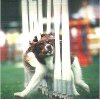 Thoughts
on... equipment Thoughts
on... equipment
When is a see-saw not a see-saw? When it won't see-saw. Have you noticed that when a
see-saw does to return, it still looks correct? occasionally this one would stick in the mud.
After hour hours I was getting really paranoid about this. When it was wrong, I did not notice.
When it was right, it looked wrong!
The table is often criticised for being hard to count
consistently and for slowing a class down. My compromise was to start the count form the moment
the dog was on the table and not insist on a down. After all, a table features in nearly every
final and top handlers and teams should be able to cope with it. At least in team events, any
counting inconsistency is evened out, not compounded. The big disadvantage of a table is that
it will show up a judge who has let his concentration wander. 'Huh, 3-1-Go' does not inspire
confidence.
Weaves with dogs whizzing through candy striped poles
with alternate striped poles will send you cross-eyed after five hours if you let them.
Dogwalks are a pain to judge. A dog only to run it once, the judge must run it for most dogs
and has to out-run them from a standing start. It is not impossible if positioned correctly but
it is very tiring. Judges be warned, some of the fastest dog walkers are not collies!
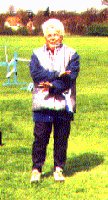 Thoughts
on... eliminations Thoughts
on... eliminations
Eliminated handlers will always get course time in my classes, especially if they
are large. The classes not the handlers! It gives me a chance to put my brain in neutral for a
few seconds. This can be as important as a coffee break if you have an efficient ring party
which keep the dogs coming.
In the team event, there were about 30 eliminations.
Let's assume they were all eliminated on average at mid-point on the course. They would have
stopped, loved or cussed the dog. Depending on their attitude, they would probably pass a few
comments with the judge or their teammates and would walk back to the finish. The dogs, being
unsupervised, will probably knock a jump over on the way. At best I would have saved 10 second
per dog. That's five minutes on the day. Big deal! As it was only one person who had been
eliminated did not look likely to finish within course time. They were asked to leave, which
they did with good grace. However, the time saved was immediately wasted when the timing
display did not rest.
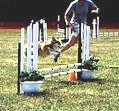 Thoughts
on... Mini Handlers Thoughts
on... Mini Handlers
They were confronted with the same course as the Crufts Team but with a pause box
instead of a table. Mini handlers will tell you their dogs cannot jump a 12" wide parallel (the
closest the wing legs would allow) are are quick to point out that the long jump at 2' 8" was
2" more that the regulation that came into force the previous month.
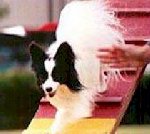 Thoughts
on... Mini Dogs Thoughts
on... Mini Dogs
They will tell you they can jump 15" hurdles with monotonous regularity and can
clear the 3' 6" A-frame contact with no problem. I feel tha the dogs are capable of much more
than the handlers will give them credit for. If it was not for the A-frame and weaves there
would be nothing much left to judge.
Thoughts on... Why do I
do it?
No, I have not given that much thought yet.
|
The Facts |
Crufts Team
Teams entered: 72 No. ran: 65
Course distance: approx. 170 yards
No. obstacles: 18 including a table
Course time: 55 seconds
Judge's circuit: 45 yards, total 6.5 miles
Actual judging rate: 52 dogs per hour
Winners: Ash Cryers
Team members: K. Smith, S. Bennett,
K. Warner, L. Keen
Time: 191.76 seconds
Faults: Clear |
Mini Agility
Entered: 60
Course time: 60 seconds
Winner: S. Manning
Dog: Arfer Collie
Time: 48 seconds
Faults: Clear
|
Reprinted with kind permission of Roy Wilce & John Gilbert from
Agility Voice (October 1992.)
|